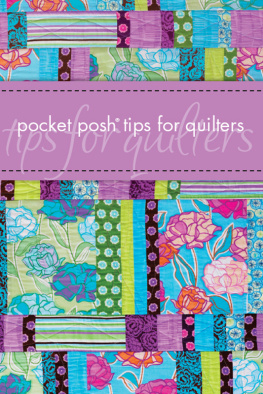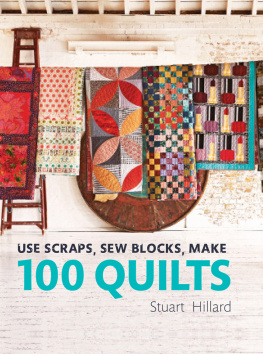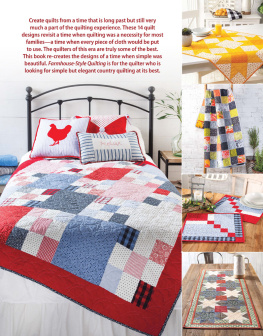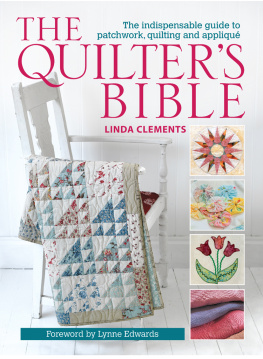HELEN KELLEYS
JOY OF
Quilting
More Wit and Wisdom from Americas
Most Popular Quilting Columnist

DEDICATION
to quilters everywhere
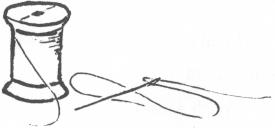
CONTENTS
PREFACE
IMAGINE THISA BEAUTY queen stands on the stage in the glow of the footlights in her teeny-tiny bathing suit and her royal sash. The contest judge asks her, And what would you like to do with your life? The fantasy queen replies, I would like to bring about world peace.
Well, I am no beauty queen, but I can tell you how I would do this. The recipe for world peace is to bring all of the international leaders together around a quilt frame. This suggestion does not sound ridiculous to anyone who has ever sat side-by-side and hip-to-hip with creative quilters, working in harmony with one another to produce something beautiful. While sitting around that quilt frame, the world leaders could sort out the troublemakers, settle international disputes, and put a whole new face on the art of cooperation and candor and creativity. How many times have you read about something or someone gone wrong, and heard a listener comment, Well, it couldnt have been a quilter who did that. From quilters you can expect integrity and generosity.
I quilt because I like to be with quilters. Its true that I love to feel fabric and that I am probably in the running for the title of Worlds Most Compulsive, Every-Day, All-Day Maker of Quilts, but its the people I meet who are the real reason why I do this quilt-thing. On most days, I work alone in my workroom. I listen to the radio while I squint at fabric to determine which colors blend and what colors make my quilt sparkle. I cut fabric. Recently, I expanded my cutting table area to the size of an entire 30x60-inch office table by adding a gigantic cutting mat; now I have a huge area where I can measure and cut and stack up my patchwork pieces to my hearts content. I sew. My sewing machine is precious to me and I treat it kindly, dusting and oiling and pampering it to keep it healthy and happy. I iron. I dont make excuses anymore for my beloved, tatty ironing board that stands permanently in the center of all this disarray, ready at a moments notice for the gentle touch of my iron, pressing my quilt blocks smooth and flat.
I know that there are some people who actually fold up their ironing boards and put them away out of sight when they are not using them. These same people dust and vacuum their workrooms, fold their neatly cut and trimmed leftover fabrics into color rainbows that shine through the clear plastic sides of their containers. Their work spaces are a triumph, indeed. My work space is not. It is home to my cutting board and sewing machine and ironing board, and I like to have them always ready for me. I tell you this because I want you to understand that making quilts truly is a passion for me, but it is not my primary passion. My primary passion is quilters themselves.
I work in a solitary manner, and periodically I realize that I miss the company of other quilters, so I go to a quilt store, or to a guild meeting, or gather with friends for coffee, and I listen to them talk. Their enthusiasm refuels me. Quilters are exciting people. Their passion is infectious. They do for me exactly what a support group should do: they support and renew me.
Then, I go back to my quiet work in the clutter of my room, refreshed. My mind whirls with the energy I have absorbed from my friends, and then, I think. I think about quilters and I think about quilts, old and new, theirs and mine. I think about the challenges and the triumphs that every quilt represents and the endurance and the love of the people who have made them, and as I think, stories emerge. My stories are about these people, all of whom I cherish.
Last night was one of those times when I felt that I needed another quilter, and so I had dinner with a friend. She gave me a presentfour large boxes of quilting rubble, things that she had rooted out of her mothers workroom when she was rearranging her own life after her mothers passing. I have spent the morning sorting through antique quilt tops and pieces of fabric folded into kaleidoscopic piles, ready to make star quilts. There is a collection of patterns, some whose envelopes have never even been opened. There are antique lace hankies and embroidered doilies, quilted pot holders and tools. And all of these things tell me a story about this quiltmaker who had treasured them.
It is obvious that she was a shopper. She bought these things with uncontrolled enthusiasm. For instance, there are a dozen metal finger protectors to be used on the forefinger of the vulnerable hand held beneath the fame when hand quilting. I am sure she did not have a dozen fingers. In the excitement of shopping, she must have bought them as gifts for her fellow quilters. She was a generous woman with a long list of friends.
She was an insightful woman. I concluded this from the big pile of old quilt blocks and the scraps and pieces that she had rescued from antique stores. She must have quivered with excitement when she discovered these treasures. They surely spoke to her, hinting to her of the lives of the women before her who had created them. She was a thrifty person and a saver, salvaging her leavings and leftovers to be recycled in future quilts.
In other words, this woman was a typical quilter. She was generous, insightful, thrifty, and, oh my, how she did love to shop! Now I am the keeper of her treasury. I will send off her antique blocks and tops to our local quilt history project so that members can learn about old fabrics and the quilters who used them. I will donate the box of folded fabrics to a church group to be used to create comforts for their mission project. I will offer the delicate hankerchiefs and hand-embroidered doilies to my quilt group to sell in their annual garage sale, a fundraising event for the scholarship fund. In this way, my friends bounty will go on as it should, extending her mothers generosity.
Back in my own little world, my workroom floor is covered with threads and quilt batt fuzz and shreds of fabric. It is a mess and it is exactly the way I like it. Ive had a wonderful idea. The mailperson brought me a box this morning, and inside, I found a collection of very old table linen. My sister had found the placemats that my mother used for us on special occasions. They are linen rectangles with silk-screened illustrations drawn by Tony Sarg, a book illustrator and puppet-maker during the 1920s and 30s. His pictures are colorful renditions of Bavarian folk art, with all its flowers and quaint flourishes. I have memories of birthday parties where these placemats decorated the table. Certainly they are too precious to use for eating on now.
So, what to do with them? Why not make memories with them for my own daughters? I will sew wall hangings. Each will be an imaginary table with a place mat on the top and bottom and a bowl of three-dimensional fabric flowers in the center. I will embellish them with fabric silverware and call each quilted hanging Dinner with Grandmother. My mind began to effervesce as the vision took hold. I didnt even stop to toss the package wrappings into the trash. I pulled out fabric from my stash and piled it on the floor. I dipped into bins of material and dug into caches at the back of my closet. I was swept up with the excitement.
Then, I sorted and cut out pieces, sewed them together, and surrounded them with walnut-colored fabric just the color of my mothers dining room table. Here and now, these little quilts are happening, just as I envisioned them. Music is playing on the radio. My heart is racing. I dash between the cutting board, the ironing board, and my sewing machine, churning out flower pieces before stitching them into quilt units and finally joining them together to make my wall-hangings. This is exactly what making a quilt should be like. I am practically vibrating with the excitement, and when I grow weary from all of this frantic activity, I will call my best quilt friend to come over for coffee so that I can tell her all about this. And that is the key to my quiltingsharing the delight. I must show these things to my friend and we will admire them together.
Next page

